In my last article we saw how to derive insights from a conventional cohort analysis and drive marketing efforts where necessary. In this article, we are going to look at doing data driven marketing using funnel analysis.
Funnels are built with a conversion action (an end goal) in mind and a series of actions leading to the conversion action over a period of time. For an ecommerce store, a funnel can consist of a series of actions a users takes before purchasing whereas for an on demand video app, it can be a series of actions a user takes before viewing a video or sharing one. One important thing to note when analyzing funnels is that it respects the chronological order of actions a user takes and in case a user repeats an action, a funnel will consider the latest one.
Here’s how a simple funnel looks like, they depict a user journey and always read top-bottom. As an app owner, it’s important to know people don’t struggle navigating through several sections of your app, for this we have added intelligence over a standard funnel by measuring the time taken by X percentile of your audience to go from step 1 to step ‘n’ or between steps, at each step by simply dragging the pointer (highlighted below in red).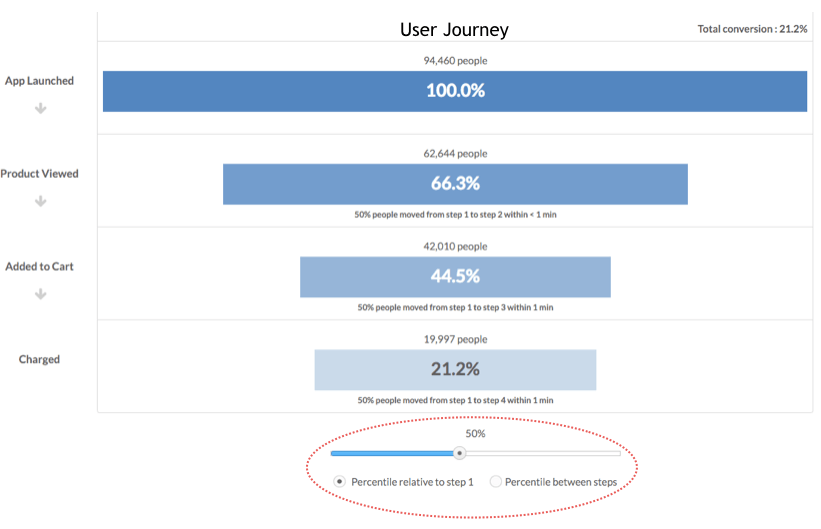
Marketing campaigns using Funnels
Funnels are often easy to analyze but you can miss subtle nuances indicating drop-offs, time bound trends or varied conversions when compared by common user properties, we’ll go through three interesting examples today.
Funnel Comparisons: Most marketers looks at funnel with an aggregate lens, but comparing them by common user properties like city, acquisitions source or platforms allow you to look at a hidden trends which you otherwise miss. A funnel comparison of users viewing products on the app shows differences by city. Users in Kingston go on to view a product 72% of the times vs. people in Kolkata, 61% of the time – a sharp difference of ~10%!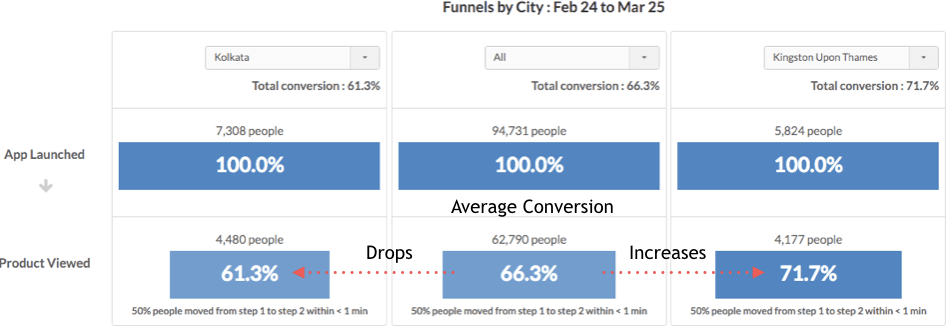
Or by acquisition source where users acquired directly seems to be more engaged in viewing products when compared to users coming from search or social media.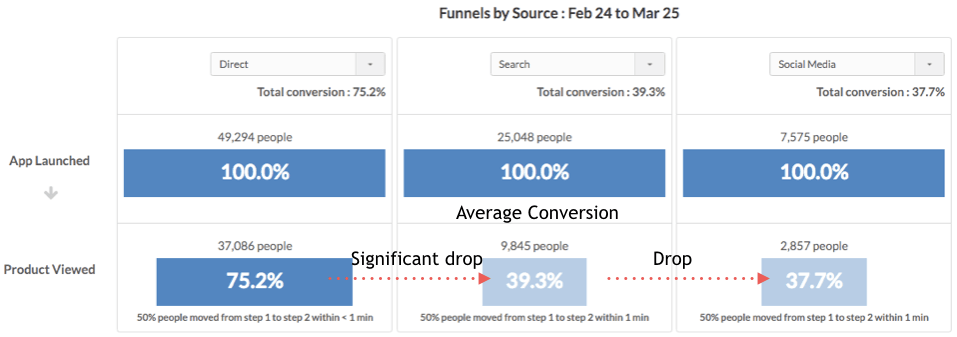
Campaign Strategy: With this kind of insight into user behavior by city/source of acquisitions, one can be proactive when sending campaigns for city/channel specific activations. Since acquisition from search or social media is getting expensive, marketers do tend to aggressively market to users aquired from paid channels compared to direct. A one time email campaign is ideal for reaching people from a city and/or users aquired from social media/search specifically.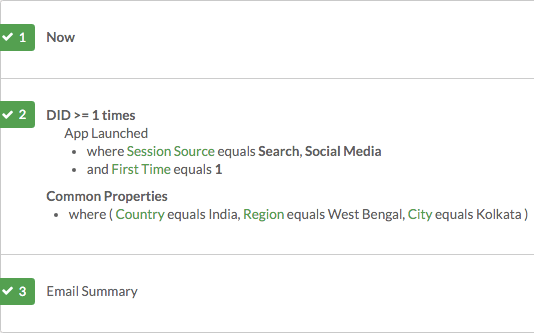
Drop-Offs: These are classic marketing funnel drop offs where people did action A but did not go on to perform action B, C or D. Abandoned carts are a big problem and the most ideal examples of funnel drop-offs.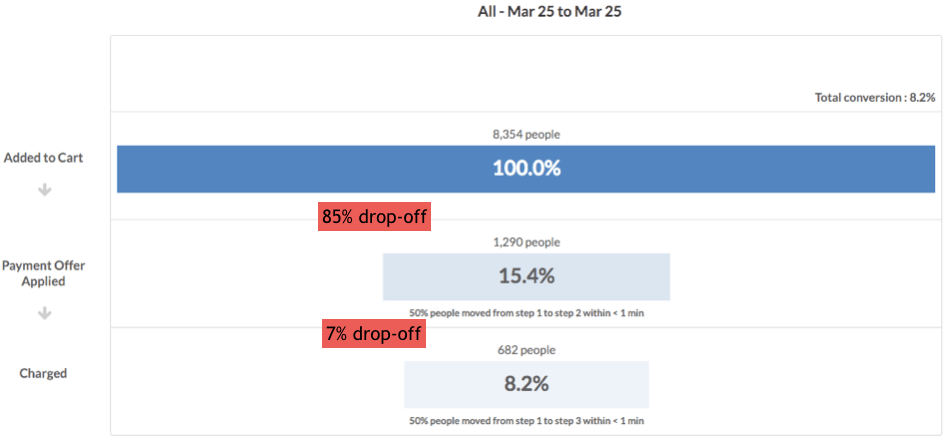 Campaign Strategy: Referencing our earlier post on bucketing users based on their lifecycle journey enables you to talk to them with a clear message pertaining to an action they just did, these kind of campaigns can be in two or more buckets. In this case, first campaign indicating towards a incentive to purchase, while the second one with a clear ‘Confirm order!’ call to action, this is how you can set them up.
Campaign Strategy: Referencing our earlier post on bucketing users based on their lifecycle journey enables you to talk to them with a clear message pertaining to an action they just did, these kind of campaigns can be in two or more buckets. In this case, first campaign indicating towards a incentive to purchase, while the second one with a clear ‘Confirm order!’ call to action, this is how you can set them up.
Funnel for a segment of users: All the funnels we saw until now were over a fixed time period but say you ran a massive user acquisition campaigns for Black Friday last year and want to analyze how those users are behaving around Black Friday this year in order to drive reengagement. Most marketers want to gain such campaign level retention insights but are unable to do so with their existing analytics set-up.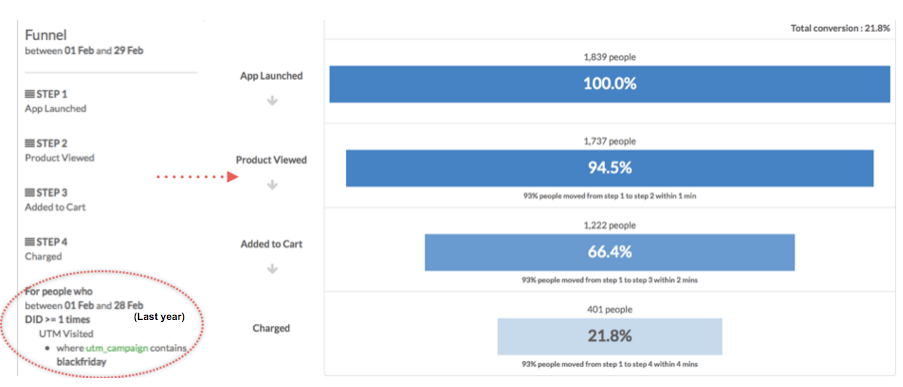
Campaign Strategy: A good campaign to run would be an email/in-app for this kind of a scenario. What’s important to take into account when running re-engagement campaigns is what items or category of items users bought/were interested in last year/visit and using that as a touchpoint to communicate with the user. Here’s how you can go about it.
Funnels not only help you visualize drop-offs but they allow you identify micro trends among common user properties & analyze series of actions people do on your website or app.
Do you have an interesting funnel in mind? Tell us more in the comments section.
Shivkumar M 
Head Product Launches, Adoption, & Evangelism.Expert in cross channel marketing strategies & platforms.
Free Customer Engagement Guides
Join our newsletter for actionable tips and proven strategies to grow your business and engage your customers.














































